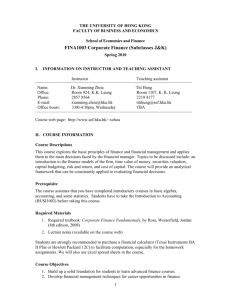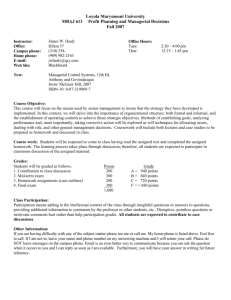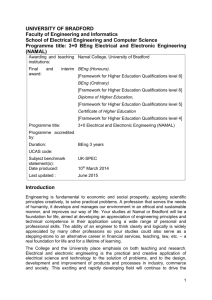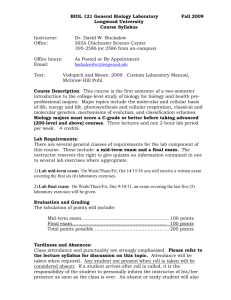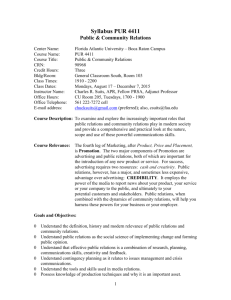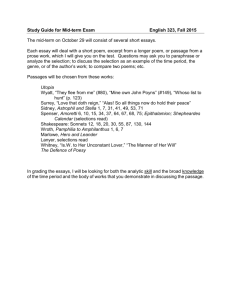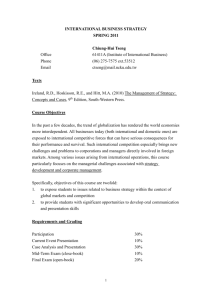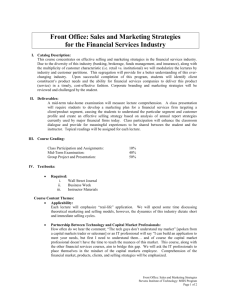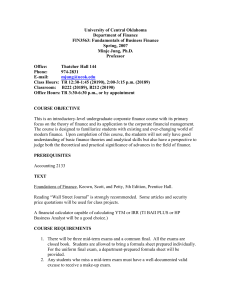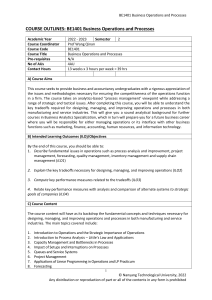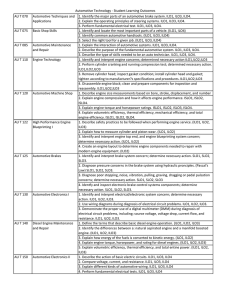THE CHINESE UNIVERSITY OF HONG KONG
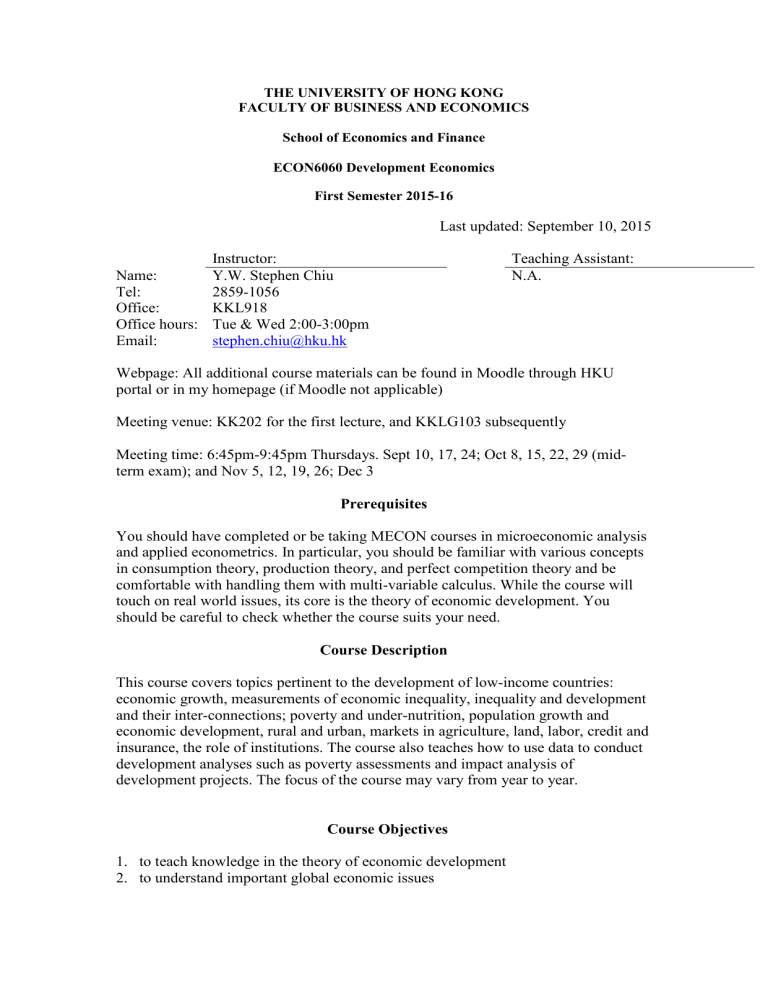
THE UNIVERSITY OF HONG KONG
FACULTY OF BUSINESS AND ECONOMICS
School of Economics and Finance
ECON6060 Development Economics
First Semester 2015-16
Last updated: September 10, 2015
Instructor: Teaching Assistant:
Name:
Tel:
Office:
Y.W. Stephen Chiu
2859-1056
KKL918
N.A.
Office hours:
Email:
Tue & Wed 2:00-3:00pm stephen.chiu@hku.hk
Webpage: All additional course materials can be found in Moodle through HKU portal or in my homepage (if Moodle not applicable)
Meeting venue: KK202 for the first lecture, and KKLG103 subsequently
Meeting time: 6:45pm-9:45pm Thursdays. Sept 10, 17, 24; Oct 8, 15, 22, 29 (midterm exam); and Nov 5, 12, 19, 26; Dec 3
Prerequisites
You should have completed or be taking MECON courses in microeconomic analysis and applied econometrics. In particular, you should be familiar with various concepts in consumption theory, production theory, and perfect competition theory and be comfortable with handling them with multi-variable calculus. While the course will touch on real world issues, its core is the theory of economic development. You should be careful to check whether the course suits your need.
Course Description
This course covers topics pertinent to the development of low-income countries: economic growth, measurements of economic inequality, inequality and development and their inter-connections; poverty and under-nutrition, population growth and economic development, rural and urban, markets in agriculture, land, labor, credit and insurance, the role of institutions. The course also teaches how to use data to conduct development analyses such as poverty assessments and impact analysis of development projects. The focus of the course may vary from year to year.
Course Objectives
1.
to teach knowledge in the theory of economic development
2.
to understand important global economic issues
3.
to develop a critical mind towards both economic theory and real world problem related to economic development
Intended Learning Outcomes
On completion of the course, students should be able to:
ILO1. understand the major problems that development countries face
ILO2. understand and be updated of the current research in development theories
ILO3. understand the empirical techniques in economic research
ILO4. be conversant with important global economic issues and be familiar with on the proposed solutions to these issues and develop their own critical views on them
Alignments of Program and Course Leaning Outcomes:
Program Intended Learning Objectives Course Intended Learning Objectives
(ILOs)
1.
Understanding of fundamental theories and new development in
ILO1, ILO2, ILO3, ILO4 economics
2.
Mastering of skills in analyzing economic data
3.
Demonstration of ability to apply economic knowledge and analytical skills to address policy and business problems
4.
Awareness of ethical concerns in economic issues
5.
Mastering of communication skills
ILO1, ILO2, ILO3
ILO3, ILO4
ILO1, ILO4
ILO4
Teaching and Learning Activities
TLA1. Lectures:
Instructor will give lectures on major concepts and issues.
TLA2. Practise questions and presentation:
Students will be asked to solve problems related to the concepts learned in class. They are also required to make in class presentations.
TLA3. Consultation:
The instructor holds weekly consultation hours to address students’ questions. Students are also encouraged to discuss questions with the instructor and TA by email or a forum in the class website.
TLA4. Guest Speaker:
Some NGO workers may be invited to give sharing.
Required Text
Ray, Debraj (1998) Development Economics . Princeton University Press (must buy!)
2
References
Banerjee, Benabou, and Mookherjee (2006) Understanding Poverty , Oxford
Economic Press,
Banerjee and Duflo (2012), Poor Economics: A Radical Rethinking of the Way to
Fight Global Poverty , Public Affairs.
Assessment
A1
Mid-term exam (Oct 29, in class)
30%
Final exam 50%
A2 short presentation & report total
20%
100%
Exams
There will be one mid-term exam and one final exam. The mid-term exam is scheduled for Oct 29 in class. The final exam will be arranged by the examination section of the university. All exams will be closed-note and closed-book. You may bring a hand-held calculator along with you while taking an exam. There is no made up exam for mid-term exam absentees. Those absent in the mid-term exam with approved reasons will have the share of the exam moved to the final exam. Any violations of academic integrity in a test or exam will result in a failing grade or a more severe punishment.
Practise Questions
You will be given practise questions after each meeting for your own practise. You are strongly recommended to work on them, either individually or as a group. Timely attempt and completion will keep you in pace with the course. Answers to selected questions may be provided.
Participation
You are encouraged to ask questions and to discuss actively in in lecture.
Presentation
3
You are asked to present in-class on a chosen topic with the aim of sharing your knowledge to a generally educated audience (your classmates). A short Q/A session will follow your presentation during which time you will take on questions pertaining to your topic. You may use power point presentation and/or aiding materials (i.e., audio-visual, handouts, etc) during the in-class presentation. Your topic must be approved by the instructor. Your presentation is scheduled for the last two meetings.
The presentation time is 5 minutes. You are welcome to form a team (no more than three people in a team).
You must submit by the deadline (October 1): 1. proposed title; 2. a brief description of the presentation topic; and 3. a bibliography of a minimum of three academic sources used in the presentation (websites do not count). Late and incomplete submissions may be penalized by grade reduction. You can always change it with instructor’s consent.
You need to hand in a report either in the form of a PowerPoint file or a short Word text file after the presentation. This file should include corrections and useful comments you received from presentation.
Relationship among Intended Learning Outcome, Teaching and Learning
Activities and Assessments
CILO
1
Teaching and Learning
Activities (TLA)
TLA1-5
Assessment (A)
A1&2
2
3
TLA1-5
TLA1-5
A1&2
A1&2
4 TLA3 A2
Standards of Assessment
Performance
Level (with Score
Range)
Assessment Rubics for the Mid-term Test and Final
Exam
Outstanding
100-80
Proficient
79-70
All or almost all of the questions are clearly and accurately responded. All or almost all of the responses are well organized, clear, fluent, and with sufficient elaboration.
Most of the questions are clearly and accurately responded. Most of the responses are well organized, clear, fluent, and with sufficient elaboration.
4
Competent
69-60
Adequate 59-50
Some of the questions are clearly and accurately responded. Some of the responses are well organized, clear, fluent, and with sufficient elaboration.
Few of the questions are clearly and accurately responded. Few of the responses are well organized, clear, fluent, and with sufficient elaboration.
Fail < 50
Very few of the questions are clearly and accurately responded. Very few of the responses are well organized, clear, fluent, and with sufficient elaboration.
The evaluation of your presentation is judged on the following five aspects:
1 Timely. Your presentation should not be longer than 10 minutes.
2. Precise and clear information. Your presentation should contain succinct information presented sequentially.
3. Depth of information. Your presentation should not be superficial, e.g., something copied from the internet. It should show that you have taken time to prepare it.
4. Objective and accurate. Your presentation should contain accurate information from reliable sources and presented in an unbiased way.
5. (Original and) Engaging. Your presentation is given for your fellow classmates so it should be engaging. Look at your fellow classmates in their eyes; don’t recite.
Performance
Level (with Score
Range)
Assessment Rubics for the Presentation
Outstanding
100-80
Proficient
79-70
Competent
69-60 satisfactory performance in all of the five aspects; excellent performance in at least one aspect satisfactory performance in 4 of the 5 aspects; excellent performance in at least one aspect satisfactory performance in 3 of the 5 aspects; excellent performance in at least one aspect
Adequate 59-50 satisfactory performance in 3 of the 5 aspects
Fail < 50 satisfactory performance in less than 3 of the 5 aspects
Academic Conduct
5
The University Regulations on academic dishonesty will be strictly enforced! Please check the University Statement on plagiarism on the web: http://www.hku.hk/plagiarism/
Academic dishonesty is behaviour in which a deliberately fraudulent misrepresentation is employed in an attempt to gain undeserved intellectual credit, either for oneself or for another. It includes, but is not necessarily limited to, plagiarism and unauthorized collaboration on out-of-class projects.
Where a candidate for a degree or other award uses the work of another person or persons without due acknowledgement:
1.
The relevant Board of Examiners may impose a penalty in relation to the seriousness of the offence;
2.
The relevant Board of Examiners may report the candidate to the Senate, where there is prima facie evidence of an intention to deceive and where sanctions beyond those in (1) might be invoked.
Course Schedule
The following schedule is tentative and will be updated accordingly.
Date Topic
Sept 10 Introduction (chapters 3 & 4)
Sept 17 Economic Growth (chapter 6)
Sept 24 Convergence & Divergence (Chapter 7)
Sept 24 Trap: Self-fulfilling prophecies & History (Chapter 8)
Oct 8 Trap: Demography (Chapter 9)
Oct 15 Trap: Income distribution (Chapter 10)
Oct 22 Trap: poverty (Chapter 8)
Oct 29 Mid-term exam
Nov 5 Labour (Chapter 13)
Nov 12 Credit (Chapter 14)
Nov 19 Optional topics
Nov 26 Student presentation
Dec 3 Student Presentation
6
